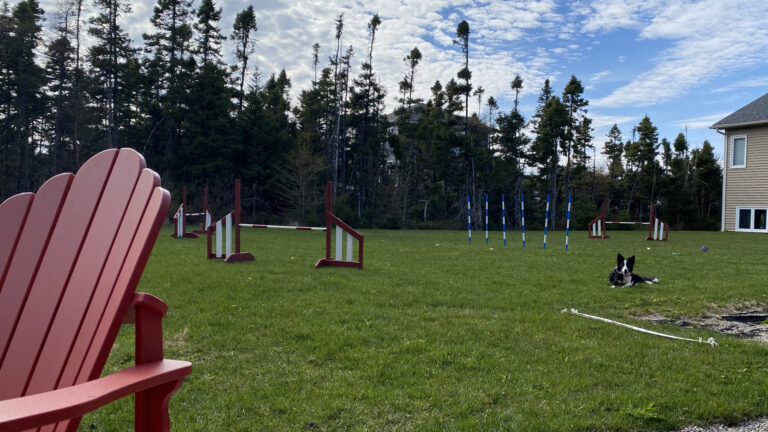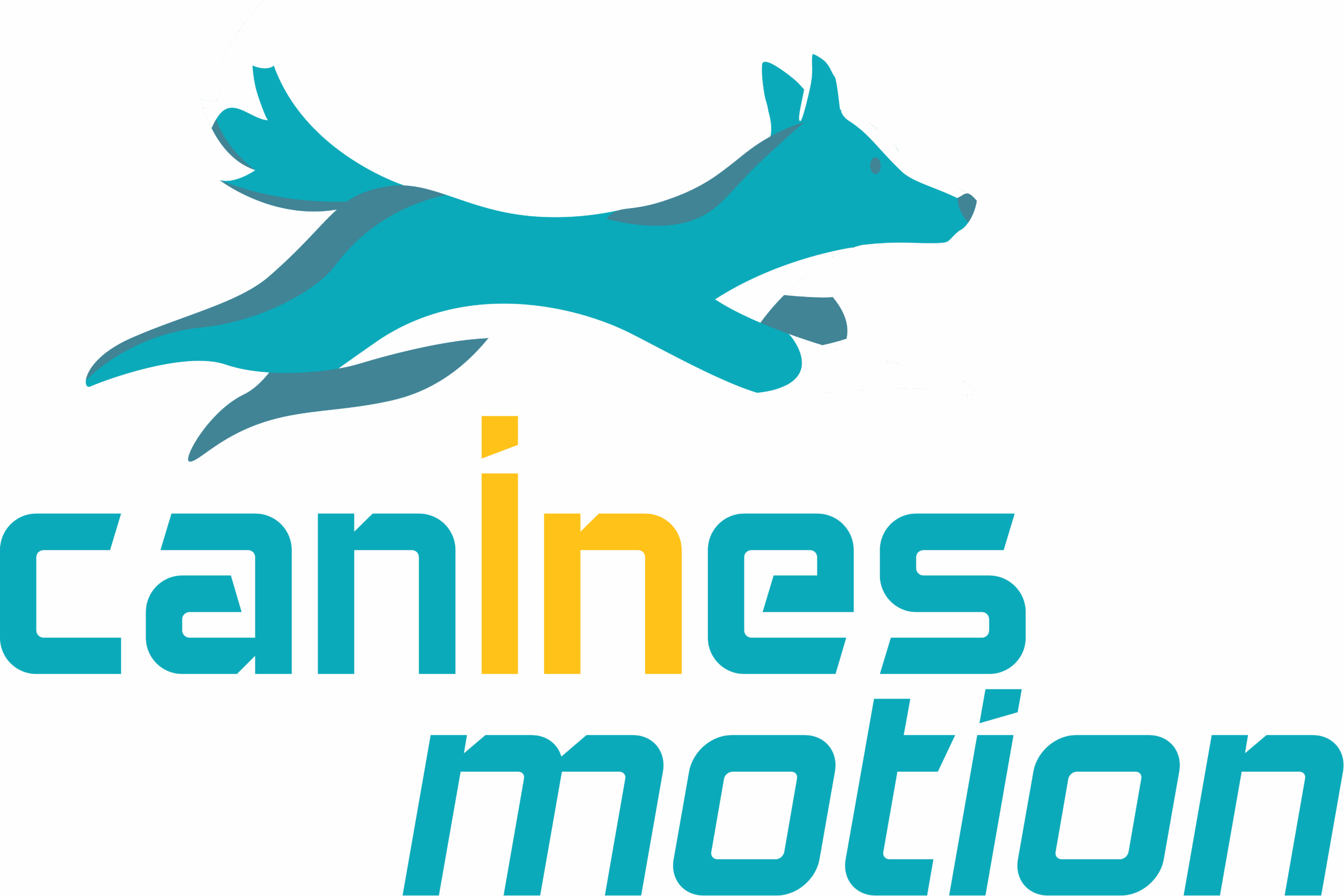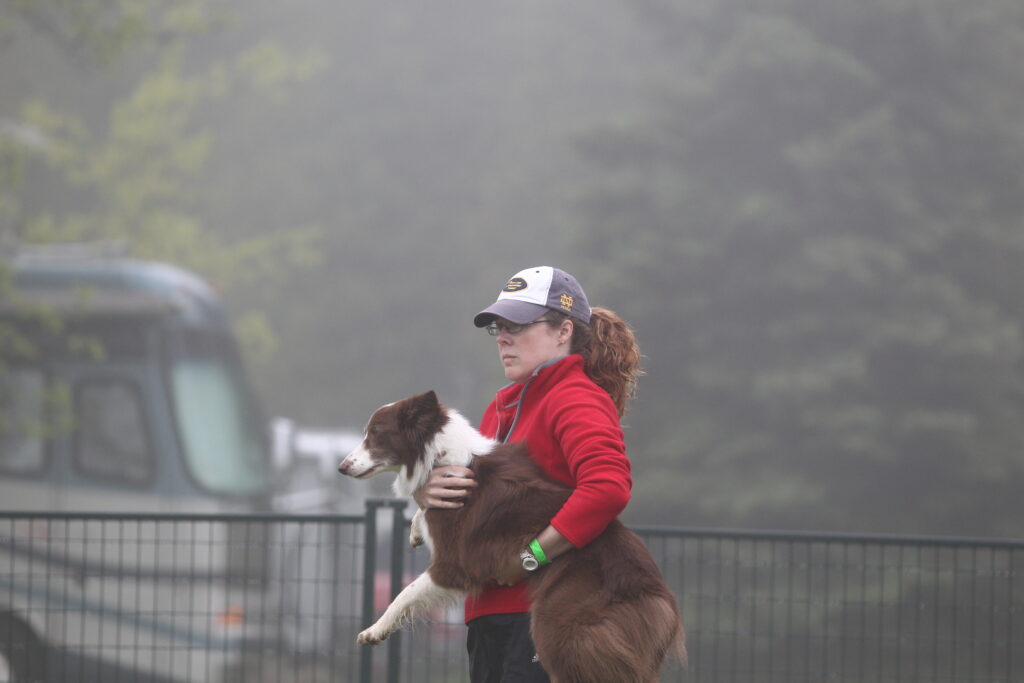Stretch, Don't Snap:
Why Challenge in Training Builds More Than Skills
Every season, I hear some version of the same thing:
“This training set looks too hard for me.”
“I don’t want to do anything challenging right before a trial… it’ll shake my confidence.”
“I’m only working on drills I know we can do right now.”
And to be honest? I get frustrated… not with the people saying it, but with what it says about how we think about training.
Somewhere along the way, we started treating practice like performance. As if clean runs, flawless execution, and ego-protection were the point of showing up to the training field.
They’re not.
Training is the place to stretch. To make mistakes. To ask questions.
It’s where you learn to think on your feet, recover quickly, and build trust with your dog… under pressure.
This post is a gentle challenge to that perfectionist mindset.
Because if you’re always playing it safe in training, you’re not preparing for the reality of the ring.
Let’s talk about the five key reasons I believe in setting challenging training courses… and how you can stretch without snapping.
These ideas aren’t just based on instinct or experience — though I’ve leaned hard on both.
They’re also grounded in decades of research on learning, motivation, motor skill development, and mindset. The work of scientists like Elizabeth and Robert Bjork (on desirable difficulties), Albert Bandura (on self-efficacy and confidence), Tim Lee (on motor learning and skill acquisition), and Edward Thorndike (who helped shape how we understand practice and transfer) has deeply influenced how I think about training.
I’m not going to cite studies here, but I hope what follows reflects the science that’s shaped how I teach, train, and grow.
1. Training is a space to build — not protect — your skills.
We don’t build strong teams by staying in our comfort zones.
We build them by exploring our edges.
I’ve seen too many handlers treat training like a dress rehearsal: everything has to go right, and if it doesn’t, they leave feeling discouraged or behind. But the truth is, the messiness of training is where the real learning lives.
When you’re slightly uncomfortable — when things don’t go perfectly — that’s when your brain (and your dog’s) starts making deeper connections. You problem-solve. You adapt. You grow.
The research world has a name for this: desirable difficulties.
It’s the idea that learning is actually better when it feels a little hard. Not impossible. Not defeating. But hard enough that you’re thinking, adjusting, and paying attention.
💡 If you can nail every drill on the first try, you’re not working at the edge of your ability.
And if you never touch the edge, how will you grow past it?
I don’t believe in hard-for-the-sake-of-hard.
But I do believe in creating spaces that push us to build — not just preserve — the skills we want in the ring.
And that’s exactly what challenging training sequences are designed to do.
2. Failure isn’t final. But it is feedback.
Let’s get one thing straight: I’m not here to glorify failure.
Failure can feel frustrating. Deflating. Personal.
And in agility, where we care so deeply about our dogs and our progress, it can hit especially hard.
But failure in training isn’t a judgment. It’s a signal.
Sometimes, it’s a cue to adjust. Sometimes, it’s a call to take a breath.
And sometimes, it’s a quiet part of a longer process that just hasn’t finished unfolding yet.
Over the weekend, I was working with Beacon on weave entries and exits.
We hit a wall. She missed the entry again and again — at least a dozen times, no matter how I adjusted the setup.
I was frustrated. She was frustrated.
Eventually, we backchained a few reps of success and then walked away. We sat by the firepit and reset for a while.
A few hours later, I brought her back out — same setup.
I couldn’t get her to miss.
That moment reminded me: learning doesn’t always show up right away.
Sometimes it needs time to settle.

There’s a concept in psychology called latent learning — the idea that even when performance doesn’t look like it’s improving, the learning may still be happening beneath the surface.
So if your dog struggles in a session, it doesn’t mean the training failed.
And if you struggle, it doesn’t mean you’re behind.
It just means the work is still in progress.
💡 Failure isn’t a verdict… it’s a doorway. If you stay open to what it’s teaching you, even quietly, it leads somewhere new.
But here’s the catch… not everyone interprets failure the same way.
That’s why in my sessions, I always say:
I set the course. You set the adventure.
Break it down. Skip the tricky bit. Celebrate one clean line.
Modify, explore, repeat…
Because when failure becomes information instead of identity, it stops being scary.
And when we see mistakes as puzzles to solve — not problems to avoid — we start training like we actually believe in growth.
🏀 Michael Jordan said it best: “I’ve failed over and over and over again in my life. And that is why I succeed.”
3. You don’t rise to the occasion — you fall back on your training.
There’s a moment we all know.
You step to the line, take a breath, and think:
I think we’ve got this… I just hope we’ve done enough.
But here’s the truth:
You don’t rise to the occasion.
You fall back on your training.
Whatever you’ve built in practice — your decisions, timing, communication, mindset… that’s what will show up when the pressure’s on.
The ring doesn’t hand you superpowers.
It reveals your habits.
That’s why I believe training should stretch you beyond the demands of competition.
The more we normalize challenge in practice, the more prepared we feel when it counts.
💡 If your hardest challenges only ever happen in competition, you’re underprepared—mentally, physically, and tactically.
This post on What Is Sport Science? breaks down those components in more detail.
This isn’t about making training brutal or overwhelming.
It’s about building capacity:
- to hold your line under pressure,
- to stay focused when things go sideways,
- and to recover quickly when they do.
And that kind of resilience doesn’t come from staying in the “safe zone.”
We see this approach all the time in elite sport:
🏀 Kobe Bryant trained six days a week, six hours a day, pushing well beyond the demands of any game.
🪖 Navy SEALs train in simulated chaos. One of their mantras says it best:
“You don’t rise to the occasion. You sink to the level of your training.”
Agility may not be life or death.
But it is a test of decision-making under pressure.
And if we never train under pressure, how can we expect to hold up when it counts?
Want the ring to feel easy?
Train like it’s hard.
4. Not all challenge is helpful. It’s how you frame it that matters.
Let’s be clear; there’s a difference between stretching and snapping.
Stretching means you’re working just outside your comfort zone.
You’re engaged, alert, and making small mistakes that help you grow.
Snapping happens when the challenge feels overwhelming, demoralizing, or impossible.
Here’s where it gets tricky:
The same sequence could feel like a productive stretch to one handler and a snap moment to another.
It’s not just about skill — it’s about perspective.
I’ve seen handlers dismiss a course before even trying it:
“This looks way too hard.”
“This is above my level.”
“I’m just going to do something easier… I don’t want to mess this up.”
But when we label a challenge as too hard before engaging with it, we don’t just protect our dogs — we protect our egos.
And that protection? It comes at a cost:
We stop learning.
We stop trying.
We miss the messy middle where progress lives.

💡 Fear of failure doesn’t keep you safe — it keeps you stuck.
That’s why in my sessions, I always say:
I set the course. You set the adventure.
You’re the pilot of your practice.
And that means you have the power to turn any course into a productive challenge — if you approach it with curiosity instead of comparison.
If you feel yourself tipping into the red zone — don’t back away.
Break it down.
Stretch, don’t snap.
5. Mindset matters more than mastery.
You can have all the technical skills in the world: spot-on timing, perfect cue clarity, beautiful handling mechanics. But if your mindset isn’t working with you, those skills won’t show up when it counts.
The voice in your head matters.
When it says:
“I’m behind.”
“Everyone else is doing better than me.”
“If I fail here, I’ve blown it.”
You shrink. You hesitate. You play small.
But when it says:
“This is hard — and that’s okay.”
“I can learn something from this.”
“Success isn’t clean — it’s curious.”
You stretch. You recover. You grow.
Your mindset is the lens that decides whether a challenge becomes fuel or fear.
And when you shift your mindset from outcome to opportunity, everything changes.
💡 You don’t have to master everything today. You just have to stay open, stay curious, and keep stepping to the line.
Final Thoughts: Stretch, Don’t Snap
Training doesn’t need to be punishing.
But it needs to be purposeful.
Because when practice feels harder, the ring feels easier.
And when we stop chasing perfection, we make space for progress.
Stretch, don’t snap.
Next time you step into a training session and walk the course…
Pause and ask yourself:
- What skill could I explore here?
- Where can I find a small win?
- What would this look like if I trained with curiosity, not comparison?
- Am I training to protect my pride… or to build my potential?
You don’t have to run the whole thing.
You just have to stay in the stretch.
🎁 Download the free Stretch, Don’t Snap Toolkit for checklists, mindset prompts, and tips to keep your training grounded and growth-focused.
—
Thanks for reading. I wrote this because I know how tempting it can be to play it safe. But I also know how much more is possible when we learn to stretch with intention. You don’t have to get it perfect. You just have to stay curious and keep showing up. See you on the field.
KC



No comment yet, add your voice below!